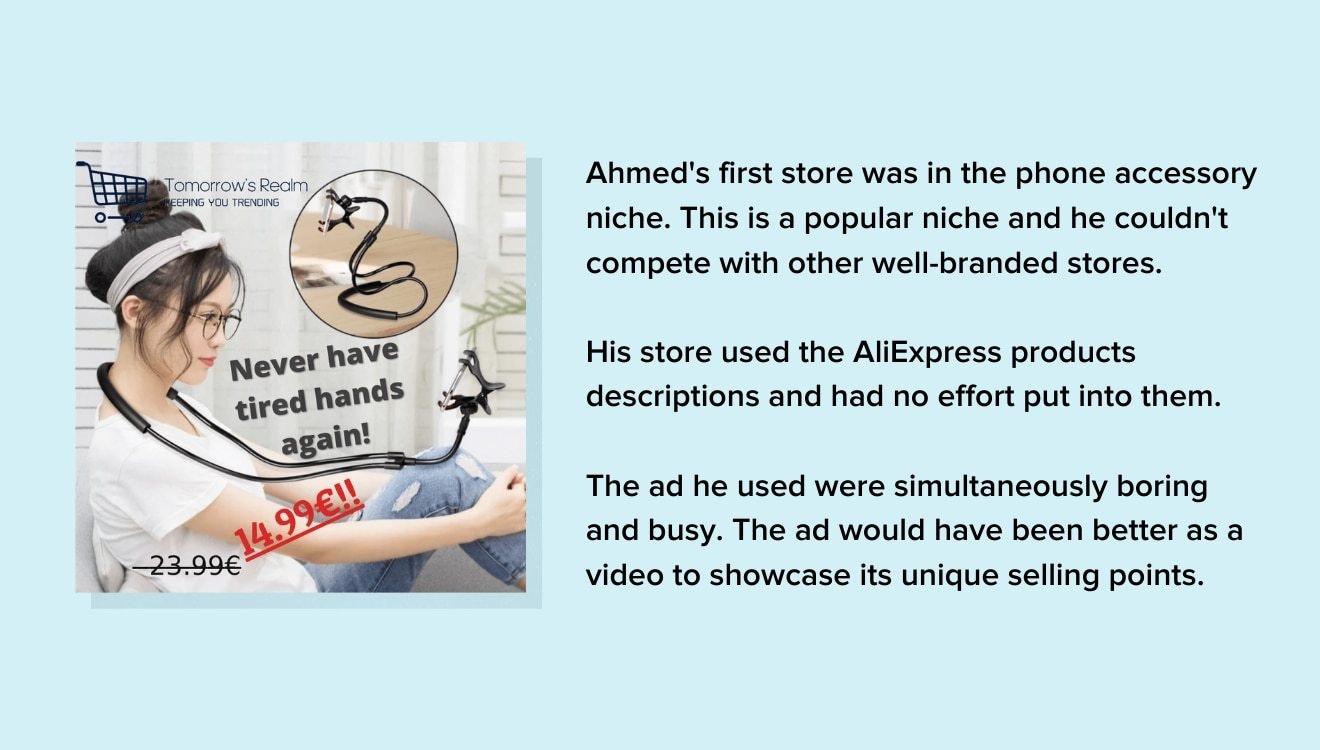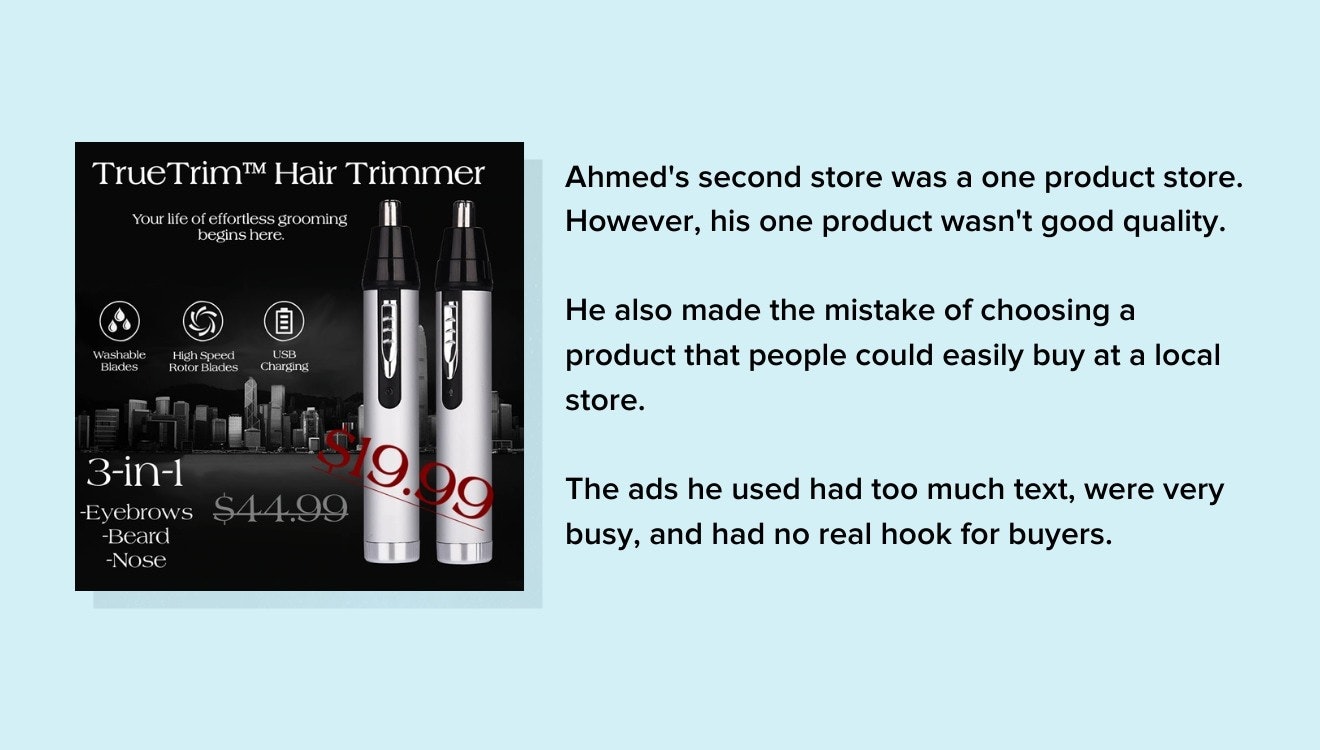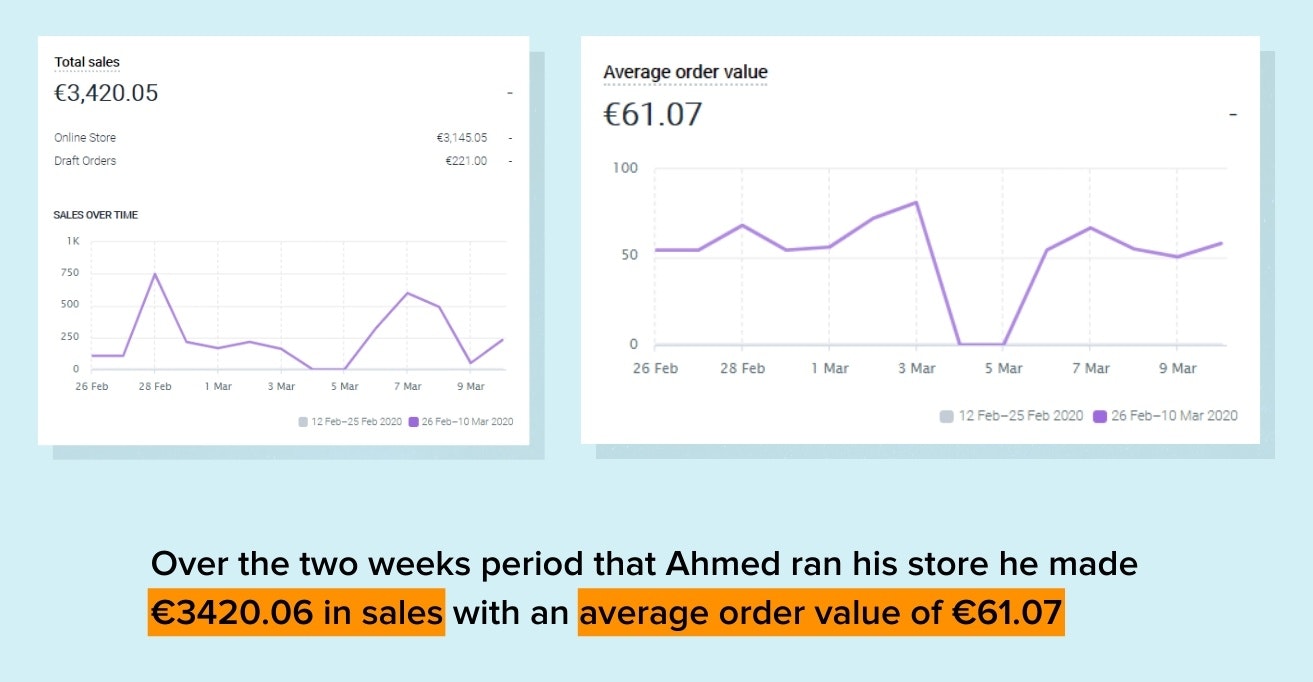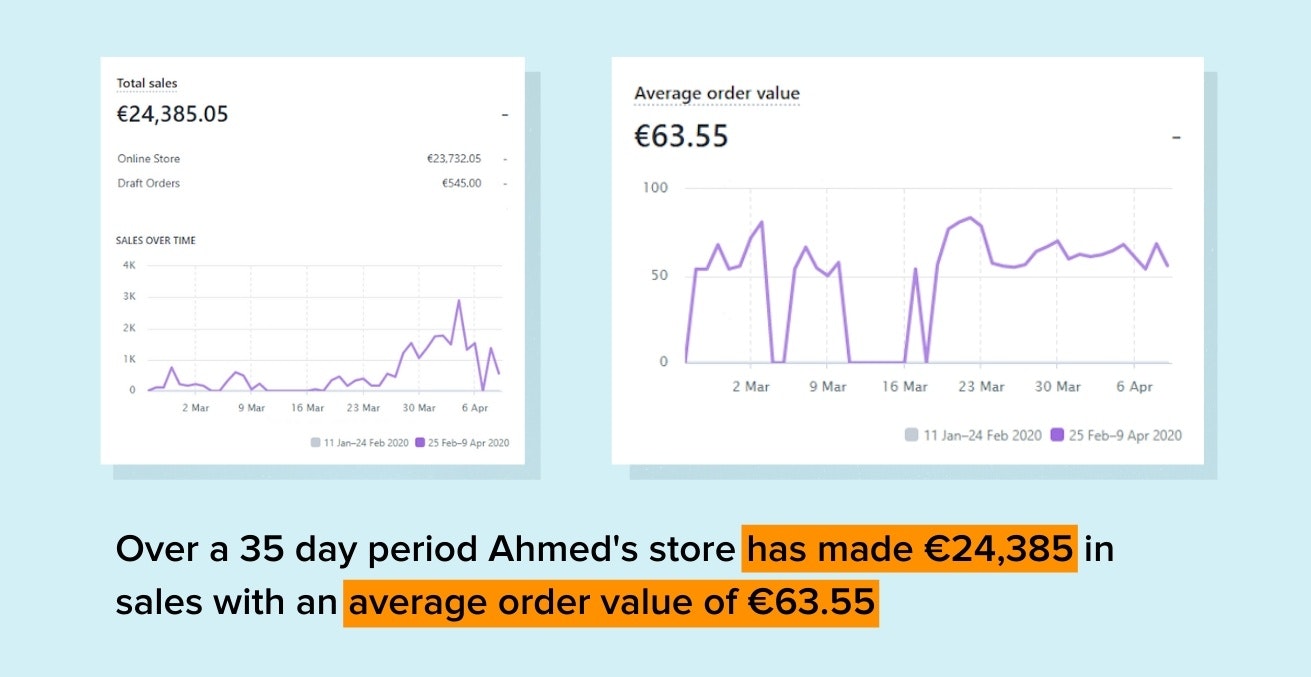When you experience failure, it can be hard to dust yourself off and try again. But if you want to become better at anything in life, that’s the only way it’s going to happen.
However, to be truly successful, you can’t just rely on trying something again, you need to figure out why you failed and fix it. And that can be the tricky part.
When I first came across Ahmed Hadi’s story of ecommerce failure and success, he had only been dropshipping for a few months. Despite that, I was instantly struck by how he reflected on his past attempts. Not only was he honest and upfront about the mistakes that he’d made, but he’d also learned from them and worked to turn his weaknesses into strengths.
Eager to learn more about what this beginner dropshipper had learned, I arranged for us to talk.
Speaking with me from Helsinki, Finland, Ahmed explained his entire dropshipping journey to date – the good, the bad, and the ugly. Unfortunately, that even included losing his day job due to the COVID-19 pandemic – right when his store was encountering problems of its own.
If you’re a beginner dropshipper and you need a little motivation, you’re going to want to read on.
Post Contents
- Mandatory Service and an Aha Moment
- Store One: A Lesson in Branding and Niche Choice
- Store Two: A Lesson in Product Quality and Choice
- Store Three: A Lesson in Timing and a Taste of Success
- Store Four: Study and Preparation
- Facebook Ads and Early Success
- New Problems Arise
- Scaling a Store During a Pandemic and Unemployment
- Expansion and Future Plans
- Want to Learn More?



Mandatory Service and an Aha Moment

Back in the spring of 2019, Ahmed Hadi had just graduated high school. Although he planned to attend university and study mechanical engineering, he deferred his start date until fall 2020 to complete his conscription service, which is mandatory in Finland.
→ Click Here to Launch Your Online Business with Shopify
It was while he was completing his six months of service that Ahmed met a friend who always seemed to have new flashy gadgets. Pretty soon, he learned the secret behind how he had the cash for his fancy accessories.
“He told us, ‘yeah, I’m into ecommerce, I do dropshipping.’ He told us that he had a shop and he did €270,000 in three months. I was like, ‘wow, how is that even possible?’ I had heard about making money online and all those ads you see on the internet, but I never really believed them, so I just took them with a grain of salt.”
After hearing about his friend’s success and learning that making money online was possible, Ahmed was intrigued by the idea of opening an online store. He began reading up on dropshipping and print on demand, and once he got out of the army in December, he made a decision.
“I was like yeah, why not, I’ll give it a shot. Because I have a nine-to-five, I went straight back to work, so I had something to work with – a starting budget.”
With a little bit of start-up cash rolling in from his job working in a parking garage at the port of Helsinki, Ahmed launched his first store.
He quickly discovered it wasn’t going to be a way to get rich quick.
Store One: A Lesson in Branding and Niche Choice
Excited by the idea of opening his first store, Ahmed was keen to get the ball rolling. He had a rough idea of how to dropship and picked up other pieces of knowledge from YouTube videos and articles as he went.
Ahmed quickly decided to open a niche store selling phone accessories. He filled it with items like fake AirPods, phone cases, and phone holders.
Ahmed now realizes that this niche is a hard one to crack in 2020. A lot of big players have already established their brand and sell identical products. And Ahmed’s approach to building a store wasn’t going to win him any customers.
“The first store I made it was sourced from AliExpress, and I took the descriptions straight from there. I didn’t really put any effort into them because I thought that if you just put the product in front of people, they would buy it, which is very wrong, of course, but that’s what I thought back then.”
With his store aimed at an American audience, Ahmed reasoned he had such a huge market that surely someone would buy his products, even without compelling product descriptions.
That wasn’t the case.
And, after advertising his products with boring, busy ads – and receiving no sales – Ahmed decided the store was a failure.
“I learned quite quickly that, first of all, my product was bad, and my approach was very bad. I didn’t have any kind of branding. I was starting like a general store, I was just trying to put everything up there and see what sticks, so I closed that pretty fast.”
With his first attempt a failure – and €100 lost to ads – Ahmed decided to start again.

Store Two: A Lesson in Product Quality and Choice
This time around, Ahmed knew he needed to focus more on branding.
“I had read about branding and how important it is – and product descriptions. I was like, OK, I’m going to brand this store really well, and hopefully, it’s going to sell.”
He decided to try a one product store, choosing a hair trimmer with various attachments. But he ignored vital clues that indicated it wasn’t a good product to sell.
“The AliExpress pictures were pretty good quality, and it looked really good and branded, but the reviews said it broke on the first use for many of them, and it felt like a toy. But I was like whatever; I didn’t really make much of it when I started the store.”
Ignoring the warning signs, Ahmed went ahead with the store and paid particular attention to improving his branding for this store. Unfortunately, it didn’t help.
“I think people saw through it, and they saw that it’s not a very good quality product.”
In addition to the product being poor quality, Ahmed realized he had chosen a product that people generally wanted immediately. And it was something they could find very easily.
“I think the biggest issue there was that hair trimmers are widely available. If someone wants a hair trimmer they’re not going to buy it online, they’re going to go to their local store.”

After realizing this store was also not going to work, Ahmed shut it down. This time he was down close to €200, and he was losing motivation.
“At this point, I’m really frustrated, and it’s not like I was going through these products fast. I was really trying, but I just didn’t have the right information and tools and knowledge.”
He realized he needed to take a step back.
Store Three: A Lesson in Timing and a Taste of Success
After spending the last four or five weeks working on his first two stores, Ahmed started investing time in learning by watching YouTube tutorials and taking notes. By the time he felt ready to launch his third store, it was a few weeks before Valentine’s Day. Armed with his new knowledge, he wanted to cash in on the holiday.
He went with a classic dropshipping product: the foil rose in a glass dome. Despite its popularity, Ahmed saw nothing but potential.
“This product is, some could say pretty saturated, but personally, I hate the word saturated because I think that with the right tools and marketing and descriptions, you could really sell anything.”
Setting up his store, Ahmed focussed on branding and advertised the product with a video ad. Finally, after two failed stores, he made his first few sales.
“It was still a big milestone that I made my first sales, and I remember I was really hyped about them. I was like, ‘Damn, this actually works.’ Because before that, it’s all like a myth, you just read about it, and you see these videos of successful people, but then you’re like, ‘What the heck? Where is my first sales?’”
Ahmed hadn’t even turned a profit with his sales, but they were enough to reassure him that ecommerce could work.
“I remember thinking, ‘OK, if this doesn’t work, then I’m gonna give up on this whole thing.’ So it was like a sign from the universe.”
Despite the sales, Ahmed realized that he only left himself a short space of time to sell his product because of shipping times. And, after just a couple of weeks he shut the store down just before Valentine’s Day.
Store Four: Study and Preparation

Even though he closed the store, Ahmed could see that the time spent studying had been worth it. He figured that if he wanted more success, he needed to learn more. He needed to understand why people quit dropshipping so that he could avoid facing the same fate. With no cash to pay for a dropshipping course, he found a free one and began studying.
He also looked into a concept called the 12 Brand Archetypes, which imagines brands fitting into one of 12 defined archetypes. The archetypes then become the brand’s personality, dictating everything from messaging, tone, colors, and images.
After studying for two weeks, Ahmed had a well-formulated plan from which to build his store.
“I had a whole notebook where I wrote stuff about what the store is gonna be like. Before even buying any domain or thinking about the name, I was like thinking about what kind of brand would I create for the store, what kind of store would it be.”
This time Ahmed opened a store in the jewelry niche with products designed to be gifted. Rather than focussing on an American audience, he went for the smaller Finnish market, which he knew better.
As he went about building his store, Ahmed didn’t focus his branding so much on his products, but the feeling they would evoke. He realized that his product’s unique selling point wasn’t the actual item itself, but the emotion that came with giving a gift.
“I only have like two, three lines about the actual product. All the rest is about the experience, the meaning of gifts, sentimental value, all that. And what I try to create is something within the lover archetype.”
Facebook Ads and Early Success
Knowing he was in a much better place than with his other three stores, Ahmed ran a CBO campaign. He used a simple, good quality picture, knowing it showed off his product better than a video.
“I used €60, and I made four sales. And with the price being €54, that’s over €216 in revenue and $60 used. I was like, ‘Wow, what the heck.’ People always say that you’re not supposed to even be profitable when testing. You’re supposed to lose money. First, I was like, “I’ve really found something now.”
Excited by this, Ahmed started scaling his store, and his sales jumped to €747.
“It was crazy. And I remember I was with my best friend and we were shopping. And you know the notification sound Shopify makes when you make a sale, it was going off every half an hour. I was like, wow, what the hell, I’m buying stuff, but I’m not even losing money, because I’m making it back all the time.”

New Problems Arise
With his store successfully making sales, Ahmed felt confident. But then he ran into a new problem: 20 unfulfilled orders. He called his supplier to see what the issue was and was told they had run out of stock.
Ahmed felt let down. His supplier had specifically promised good communication, yet they hadn’t told him about the stock issue until he rang them. But, before he had time to sort out his supplier issue, another problem popped up.
Because Ahmed’s products came to Finland from outside the European Union, they were subject to customs fees. And now he had customers wanting to know why they had to pay customs fees on the products.
Thankfully, customs had only caught five of around 60 orders that had come into the country. To solve the immediate problem, Ahmed reimbursed his customers for the fee. But this wasn’t a long term solution.
With tensions rising due to his supplier’s lousy communication, and some packages incurring fees, Ahmed turned off his ads. He knew he had a successful brand but needed to overcome these issues before scaling any further.
But before Ahmed could iron out his store’s problems, something else happened: He lost his job.
Scaling a Store During a Pandemic and Unemployment

With Coronavirus spreading worldwide, countries were quickly closing borders. This included the daily passenger ferries that went from Helsinki to Stockholm, Sweden. With no passengers at the port, Ahmed was no longer needed.
With his job gone and his university course not starting for months, Ahmed threw himself back into his store. The loss of that regular income hurt, but he was hopeful he could make up for it with his store. Initially, he had wanted to use a new supplier – one based within the EU – but decided to try and work things out with his original supplier first.
After a lengthy discussion about his concern and frustrations, Ahmed’s supplier was understanding. And, once they promised to be more prompt with communication, Ahmed was happy to continue using them. He also fixed his customs issues with an easy solution: Honesty.
“A simple workaround that I didn’t think about was to just be transparent and say that customs and tax fees have to be paid upon arrival. Sure, it affects conversions, but that can all be compensated with a good product, good branding, good customer service, and transparency in general.”
With these issues solved, Ahmed turned his ads back on and focussed on scaling. And, when I spoke with him on April 9, he was brimming with good news.
Incredibly, his store made almost €21,000 in sales in the 22 days since we last spoke. And there are no signs of sales slowing down.

Expansion and Future Plans
After resolving his supplier and customs problems, Ahmed’s store is thriving. But as he’s demonstrated throughout this whole journey, Ahmed’s someone who’s hungry to do better and achieve more.
“As a result of my revival, I have actually managed to scale the store in the middle of the pandemic. I am now at a point where I am actually going to expand abroad to other untapped markets with higher populations than in Finland.”
Even with his store rapidly growing, Ahmed still plans to attend university in the fall. And eventually, he’d love to combine his degree with ecommerce to make a living. However, his mid-term goal is to be able to live off his store while he studies.
And in the short-term? Well, he’s excited to be entering new markets and hopes that sharing his struggle can act as the inspiration that other beginners need.
“I think it serves as a great example for beginners about how dealing with issues instead of letting them drag you down really pays off. Especially since all of this is happening in the middle of the pandemic.”



